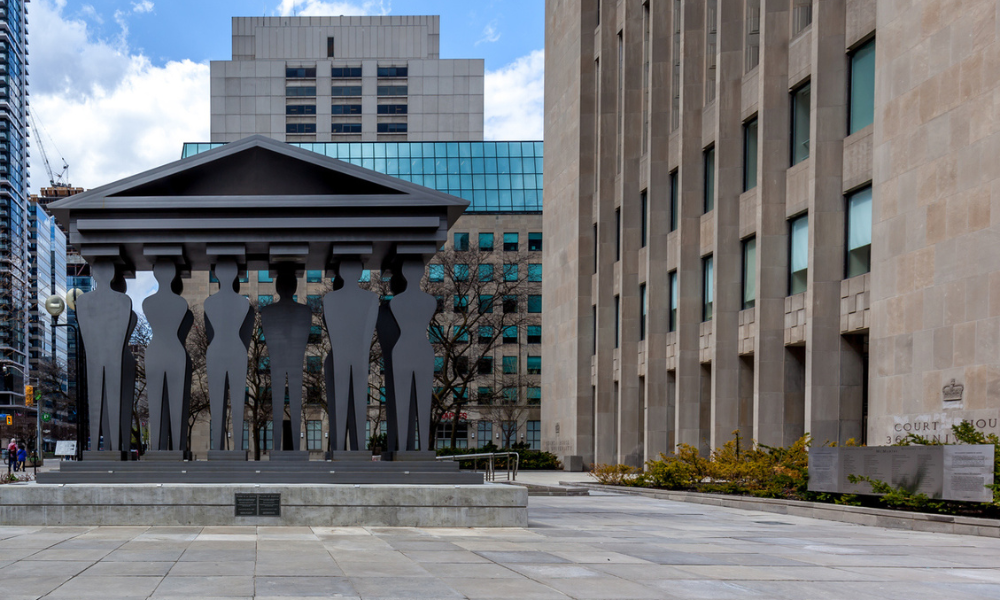A fight over a boat and the meaning of public space has the Town of Niagara-on-the-Lake battling a citizens’ group all the way to the Court of Appeal.
 “It has every piece of law you can think of,” says Robert Doumani, a partner with Aird & Berlis LLP who is representing the citizens’ group, the Niagara River Coalition.
“It has every piece of law you can think of,” says Robert Doumani, a partner with Aird & Berlis LLP who is representing the citizens’ group, the Niagara River Coalition.
At issue is the town’s decision to pass a bylaw authorizing Niagara Gorge Jet Boating Ltd. to lease a dock near the Niagara River for its amusement ride business. It was the third time the town had done so, allowing Jet Boat to continue running a service it had operated there since 1992.
But last year, the residents’ group, fed up with the resulting noise and disruption, challenged the bylaw. They argued the decision flew in the face of the town’s official plan that prioritizes public access to the waterfront as well as designating the dock as a conservation area.
As a result, they asked the Ontario Superior Court to strike down the bylaw because, they alleged, the inconsistency with the official plan violated Ontario’s Planning Act.
Last month, Justice Joseph W. Quinn agreed with the residents, which essentially forced the temporary closure of the Jet Boat operation. “Both the [Niagara] region’s official plan and [Niagara-on-the-Lake’s] official plan contain public-access policies, and those policies are being thwarted by the exclusive use being made of the dock by Jet Boat,” Quinn wrote in Niagara River Coalition v. Niagara-on-the-Lake (Town).
“Public means public,” says Doumani, noting people had no way to get on the dock unless they had a Jet Boat ticket or wristband. “The fence is locked when the jet boat is not in operation. How that was public access was beyond me.”
The town, however, disagrees and is taking the case to the appeal court. The case will go to a hearing on Sept. 9. In the meantime, the court has stayed Quinn’s ruling, allowing Jet Boat to resume its operations this summer.
In his decision, Quinn noted the long history of the dock, which originally was owned by the federal government as a customs point for almost 30 years ending in 1991.
That year, ownership of the dock, which was zoned for institutional use, went to the town in order to facilitate the jet boat operation. Since then, the business, characterized as “exciting, wet, and exhilarating,” has grown to four boats carrying up to 54 riders.
Ridership grew from 41,000 nine years ago to 82,000 in 2007, Quinn wrote, noting the operation has the potential to carry 150,000 people per season.
“This operation has grown incredibly over time and has the capacity to grow even more,” says Doumani, citing the coalition’s decision to take action 16 years after Jet Boat began running there.
In his ruling, Quinn made reference to neighbours’ disregard for the business. “The Jet Boat operation has negative impacts on nearby residents. These include fumes, trespass, noise, vibration, litter, and invasions of privacy,” he wrote, adding that the business nevertheless generates significant revenues for local governments as well as economic activity.
“An economic study calculated the impact, for the Niagara region, of visitor spending, operation expenses, and investment expenditures, flowing from the Jet Boat operation. The ‘overall direct impact’ was quantified at $42.1 million, ‘resulting in 549 jobs and directly generating $443,440 in municipal taxes.’
This same study calculated ‘the total direct, indirect, and induced economic impact of [the Jet Boat operation] on the overall regional economy to be $77.1 million.’”
Quinn’s ruling, of course, turned on the legal questions rather than the economic ones. Noting that the Regional Municipality of Niagara’s official plan emphasizes “maximizing public access” to its Great Lakes, Quinn pointed out that since 1974, Niagara-on-the-Lake has also prioritized buying waterfront lands for public open space and recreation.
In 1986, an amendment to the town’s official plan banned new commercial operations on the water along with a proviso that the municipality would try to reduce the number of non-conforming uses where possible.
Then, the current official plan passed in 1994 added the notion of conservation areas allowing for main and secondary uses. A secondary use could only occur along with a main use, which included activities such as forestry, wildlife management, environmental protection, and public and private parks.
“It will be noted that no commercial activities are listed under ‘main uses,’” Quinn wrote. “Furthermore, permitted uses do not include anything resembling a private commercial operation such as the one conducted on the dock by Jet Boat (an amusement ride on the Niagara River for paying customers) . . . [Niagara-on-the-Lake’s] official plan did not intend ‘private and public parks’ to include active parks such as concession stands, sports fields, and amusement rides.
The intention was for these parks to be open space and/or natural areas having limited (if any) structures and a low-intensity use.”
At the same time, while a planner speaking for the town argued the dock’s designation for institutional use permitted a public park and therefore justified the bylaw, Quinn said that was instead a reason for rejecting it. “If the dock is a park, keeping it fenced and locked, except for paying customers of Jet Boat, means it is not a public park.”
Quinn further ruled that the Jet Boat business didn’t constitute a legal non-conforming use of the dock given the town’s policies on gradually eliminating such situations where possible.
As well, he decided the town’s move to lease the dock to Jet Boat without declaring the property to be surplus and without putting it out for tender violated its own policies on disposing of publicly owned holdings.
The town, of course, argues otherwise, which is why Lord Mayor Gary Burroughs says it has decided to appeal Quinn’s ruling. “The judge was very clear on the decision he’d made but did not make reference to some of the issues our lawyers were arguing on,” he tells Law Times.
The appeal notice states 22 grounds for overturning Quinn’s ruling, including arguments that federal legislation allows successive owners to maintain the dock for intense commercial uses. As well, it says the official plan includes no definition of what an acceptable use of a private or public park is.
In addition, Quinn “erred in concluding that the fencing off and/or locking a portion of a park means that the park is not a public park,” according to the notice.
Doumani, of course, challenges those claims, arguing the breadth of the town’s appeal amounts to a “shotgun” approach. Still, he hopes that Quinn’s ruling and the potential outcome of the appeal will serve as a warning to other towns and cities to ensure conformity with their official plans. “I think sight of that gets lost . . . It does say, ‘Look - keep an eye on your official plan.’”
 “It has every piece of law you can think of,” says Robert Doumani, a partner with Aird & Berlis LLP who is representing the citizens’ group, the Niagara River Coalition.
“It has every piece of law you can think of,” says Robert Doumani, a partner with Aird & Berlis LLP who is representing the citizens’ group, the Niagara River Coalition.At issue is the town’s decision to pass a bylaw authorizing Niagara Gorge Jet Boating Ltd. to lease a dock near the Niagara River for its amusement ride business. It was the third time the town had done so, allowing Jet Boat to continue running a service it had operated there since 1992.
But last year, the residents’ group, fed up with the resulting noise and disruption, challenged the bylaw. They argued the decision flew in the face of the town’s official plan that prioritizes public access to the waterfront as well as designating the dock as a conservation area.
As a result, they asked the Ontario Superior Court to strike down the bylaw because, they alleged, the inconsistency with the official plan violated Ontario’s Planning Act.
Last month, Justice Joseph W. Quinn agreed with the residents, which essentially forced the temporary closure of the Jet Boat operation. “Both the [Niagara] region’s official plan and [Niagara-on-the-Lake’s] official plan contain public-access policies, and those policies are being thwarted by the exclusive use being made of the dock by Jet Boat,” Quinn wrote in Niagara River Coalition v. Niagara-on-the-Lake (Town).
“Public means public,” says Doumani, noting people had no way to get on the dock unless they had a Jet Boat ticket or wristband. “The fence is locked when the jet boat is not in operation. How that was public access was beyond me.”
The town, however, disagrees and is taking the case to the appeal court. The case will go to a hearing on Sept. 9. In the meantime, the court has stayed Quinn’s ruling, allowing Jet Boat to resume its operations this summer.
In his decision, Quinn noted the long history of the dock, which originally was owned by the federal government as a customs point for almost 30 years ending in 1991.
That year, ownership of the dock, which was zoned for institutional use, went to the town in order to facilitate the jet boat operation. Since then, the business, characterized as “exciting, wet, and exhilarating,” has grown to four boats carrying up to 54 riders.
Ridership grew from 41,000 nine years ago to 82,000 in 2007, Quinn wrote, noting the operation has the potential to carry 150,000 people per season.
“This operation has grown incredibly over time and has the capacity to grow even more,” says Doumani, citing the coalition’s decision to take action 16 years after Jet Boat began running there.
In his ruling, Quinn made reference to neighbours’ disregard for the business. “The Jet Boat operation has negative impacts on nearby residents. These include fumes, trespass, noise, vibration, litter, and invasions of privacy,” he wrote, adding that the business nevertheless generates significant revenues for local governments as well as economic activity.
“An economic study calculated the impact, for the Niagara region, of visitor spending, operation expenses, and investment expenditures, flowing from the Jet Boat operation. The ‘overall direct impact’ was quantified at $42.1 million, ‘resulting in 549 jobs and directly generating $443,440 in municipal taxes.’
This same study calculated ‘the total direct, indirect, and induced economic impact of [the Jet Boat operation] on the overall regional economy to be $77.1 million.’”
Quinn’s ruling, of course, turned on the legal questions rather than the economic ones. Noting that the Regional Municipality of Niagara’s official plan emphasizes “maximizing public access” to its Great Lakes, Quinn pointed out that since 1974, Niagara-on-the-Lake has also prioritized buying waterfront lands for public open space and recreation.
In 1986, an amendment to the town’s official plan banned new commercial operations on the water along with a proviso that the municipality would try to reduce the number of non-conforming uses where possible.
Then, the current official plan passed in 1994 added the notion of conservation areas allowing for main and secondary uses. A secondary use could only occur along with a main use, which included activities such as forestry, wildlife management, environmental protection, and public and private parks.
“It will be noted that no commercial activities are listed under ‘main uses,’” Quinn wrote. “Furthermore, permitted uses do not include anything resembling a private commercial operation such as the one conducted on the dock by Jet Boat (an amusement ride on the Niagara River for paying customers) . . . [Niagara-on-the-Lake’s] official plan did not intend ‘private and public parks’ to include active parks such as concession stands, sports fields, and amusement rides.
The intention was for these parks to be open space and/or natural areas having limited (if any) structures and a low-intensity use.”
At the same time, while a planner speaking for the town argued the dock’s designation for institutional use permitted a public park and therefore justified the bylaw, Quinn said that was instead a reason for rejecting it. “If the dock is a park, keeping it fenced and locked, except for paying customers of Jet Boat, means it is not a public park.”
Quinn further ruled that the Jet Boat business didn’t constitute a legal non-conforming use of the dock given the town’s policies on gradually eliminating such situations where possible.
As well, he decided the town’s move to lease the dock to Jet Boat without declaring the property to be surplus and without putting it out for tender violated its own policies on disposing of publicly owned holdings.
The town, of course, argues otherwise, which is why Lord Mayor Gary Burroughs says it has decided to appeal Quinn’s ruling. “The judge was very clear on the decision he’d made but did not make reference to some of the issues our lawyers were arguing on,” he tells Law Times.
The appeal notice states 22 grounds for overturning Quinn’s ruling, including arguments that federal legislation allows successive owners to maintain the dock for intense commercial uses. As well, it says the official plan includes no definition of what an acceptable use of a private or public park is.
In addition, Quinn “erred in concluding that the fencing off and/or locking a portion of a park means that the park is not a public park,” according to the notice.
Doumani, of course, challenges those claims, arguing the breadth of the town’s appeal amounts to a “shotgun” approach. Still, he hopes that Quinn’s ruling and the potential outcome of the appeal will serve as a warning to other towns and cities to ensure conformity with their official plans. “I think sight of that gets lost . . . It does say, ‘Look - keep an eye on your official plan.’”







